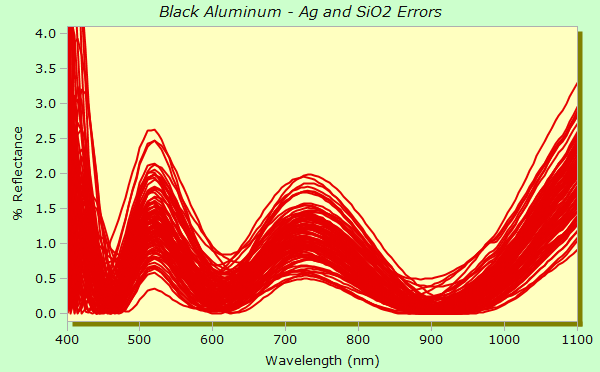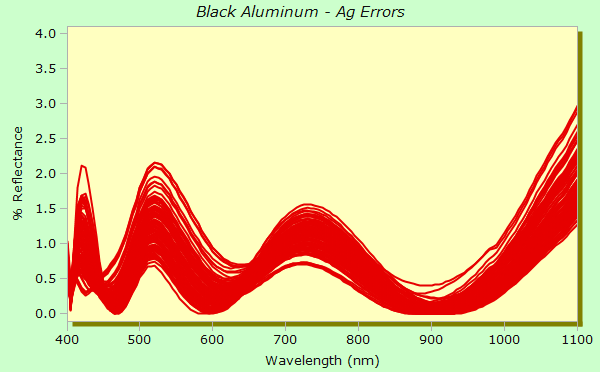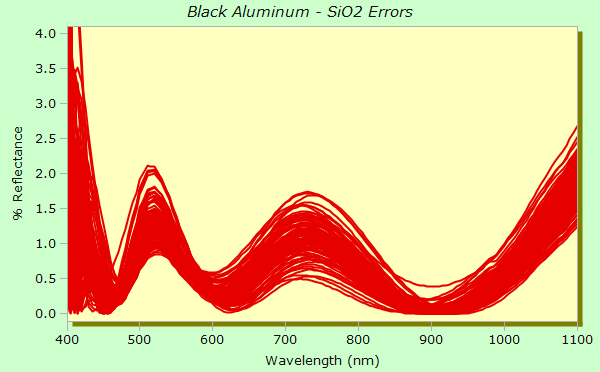|
Technical Issues
-
Double Dispersion
We apply the term Double Dispersion to materials wherein n,k varies with thickness AND wavelength. Experts have long advised that thickness-dependent dispersion be ignored in thin film design. Consider the following statement in a comprehensive review of coatings containing metal-dielectric composite films.
This makes sense for design software
limited to wavelength dispersion.
Double Dispersion, based on
bilinear interpolation, removes this restriction, offering
new possibilities for utilizing thickness-dependent materials.
See "Designing with very thin optical films", R. R. Willey, A. Valavičius, F. T. Goldstein,
Appl. Opt. 59, A213-A218 (2020). FilmStar DESIGN's
Index Formulator gives smooth transition
between n,k tables. In cases where the Formulator is
insufficient, indices can be computed in Excel, the FilmStar
Workbook or FilmStar BASIC.
Click here for
our 2021 SVC PowerPoint presentation Specifying n&k in
Optical Thin Film Calculations (also available on
YouTube).
Since the Index Formulator includes ANG/IFP/IFS variables, Triple Dispersion is also possible.
This topic discusses advanced
features which might
be unfamiliar: Stack Mode and Index Formulator. Please contact FTG Software for assistance.
Coating engineers generally design
with dielectrics, for which it is assumed that dispersion
depends only on wavelength. But what about materials where dispersion changes with layer thickness,
e.g. metal films
thinner than the percolation threshold? A general
solution, independent of theoretical approximation, is now available through variable THK in User-Defined Index Functions
(Formula tab). Consider Function LTHICK where L=1.3 for layers <75 nm and 1.46
for layers >=75 nm and Function HTHICK where H=2.1 for
layers <75 nm and 2.3 for layers >=75 (not
realistic materials, just a simple example to understand and
verify Formulas).
 HTHICK Dispersion Function Why minus signs? The logic operator () returns -1 if True and 0 if False. This gives us a coating with four layers and two film materials where n,k varies with thickness. We compare and verify with a four layer coating as follows:
 Equivalent Four Material Design
We can verify that THK variables
works correctly by overlapping spectra generated from Two
Material and Four Material designs.
Note also that Index Functions can include up to three n,k
tables.
-(THK<75)*N1-(THK>=75 & THK<150)*N2-(THK>=150)*N3
Examples may be
downloaded here. Index file TiO2_Mod.itw was created by
manipulating TiO2_Orig in Excel, wherein n was multiplied by 0.8
and k by 1.2.
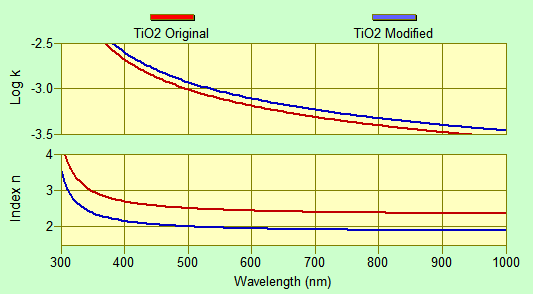 Thanks to Ron Willey for suggesting these modifications. Please contact Ron for further information about his work in this area. Note also that the Groups Mode editor includes Inhomogeneous Layer Replacement which applies to materials like ZrO2.
As three index tables
may be insufficient to describe metal films, the number was
increased to nine in DESIGN 2.61.4400 and INDEX 2.51.0600 (NOTE
below). A simple approach is to utilize multiple tables where
each is valid over a given thickness range. Unfortunately that
gives discontinuities wreaking havoc in refinement. It seems
reasonable to interpolate n,k for intermediate
thicknesses. That requires formulas beyond the ability to
edit and verify in the single line editor shown below.
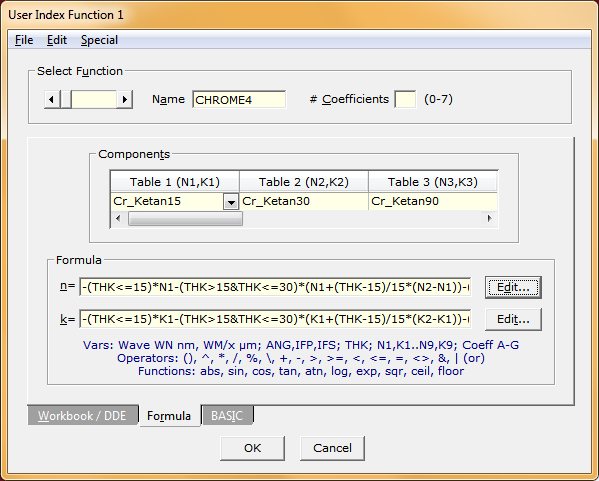
We therefore added the Index
Formulator. Our four Cr index tables
correspond to 15 nm, 30 nm, 90 nm and (Palik) 600 nm. We assign
(N1,K1) for t<=15 nm, mix (N1,K1) and (N2,K2) for t between 15
and 30 nm, mix (N2,K2) and (N3,K3) for t between 30 and 90 nm,
etc. Index tables were deduced by Ron Willey from data supplied
by Ketan Patel (Luma Optics Mumbai). Unfortunately there
were no measurements for films > 90 nm so are
making do with
Palik's value.
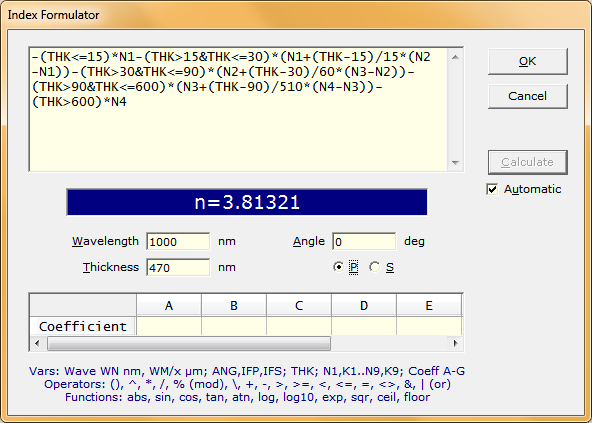
Users can verify calculations in
INDEX. As shown in the plot below, interpolation eliminates
jumps (blue trace) resulting from small thickness changes. The success of these algorithms depends on one's ability
to determine n,k for a range of film thicknesses. It also
assumes, for example, that n,k at 45 nm is halfway between n,k
at 30 nm and n,k at 60 nm. Results from
ellipsometry (high angle) are useful, but may not accurately
predict %R/%T at normal incidence. Users can verify index values
in DESIGN as described
here.
Click here to download files. Copy *.itw to C:\Winfilm\Index, *.itf to C:\Winfilm\Config, and *.faw to C:\Winfilm\Designs. Note: *.itf files are User-Index Function Collections. File..Open in the User-Index Function dialog opens a Collection. There should be two Index Functions: CHROME4 and CHROME3. CHROME4 interpolates n,k values; CHROME3 does not, illustrating why interpolation is critical. 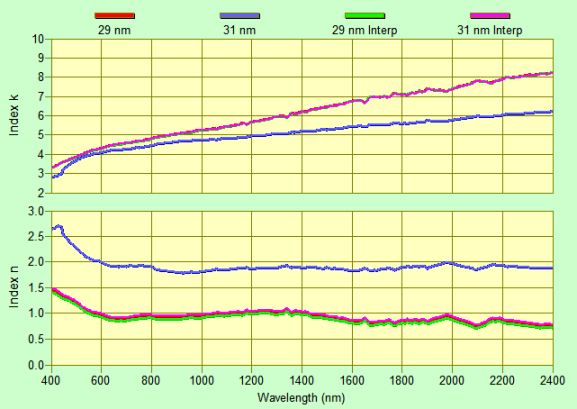 The plot below indicates interesting possibilities for metal-dielectric designs. In this case there are four Ag files, corresponding to n,k deduced at 2, 5, 10, 20 nm. A tolerancing plot is displayed at the bottom of this page. Attempts to design AR coatings by fixing Ag layers ("must not be varied") and varying only SiO2 layers have so far been fruitless. Of course, the proof is in the pudding, and we look forward to hearing from users who have fabricated such designs. How well do they correspond to theory? Are results repeatable? It seems reasonable that single Ag layers for n,k determination be deposited onto SiO2 substrates coated with an SiO2 film. The first design layer would then be SiO2 so that a metal is never deposited on a bare substrate. 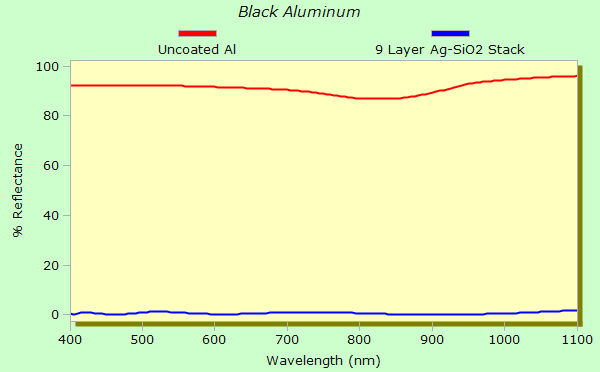 The Index Formulator does not require THK variables or Stack Mode. It is especially useful for mixed materials and alloys, as in this example: Al(x)Ga(1-x)As. 3. Tolerancing The following BASIC program generates tolerancing plots in FSPlot.
To gain insight we implement Monte-Carlo tolerancing, varying all layers and then only Ag and only SiO2. The following was generated with the 9 layer Ag-SiO2 with SiO2 SD = 2% and Ag SD = 0.2 nm.
In the following we varied only Ag with SD = 0.2 nm (2 Ångstroms). This was accomplished by commenting-out the "SIO2" StackIndexSet command in the above FilmStar BASIC code.
In the following we varied only SiO2 with SD = 2%.
The sensitivity to Ag thickness variation suggests that the ability to optimize metal layers during optimization is crucial for achieving AR design goals. FilmStar users needing help with the above are urged to contact FTG Software to arrange a ZOOM meeting. |
Copyright © 2023 FTG Software Associates
Last updated on
October 11, 2023

